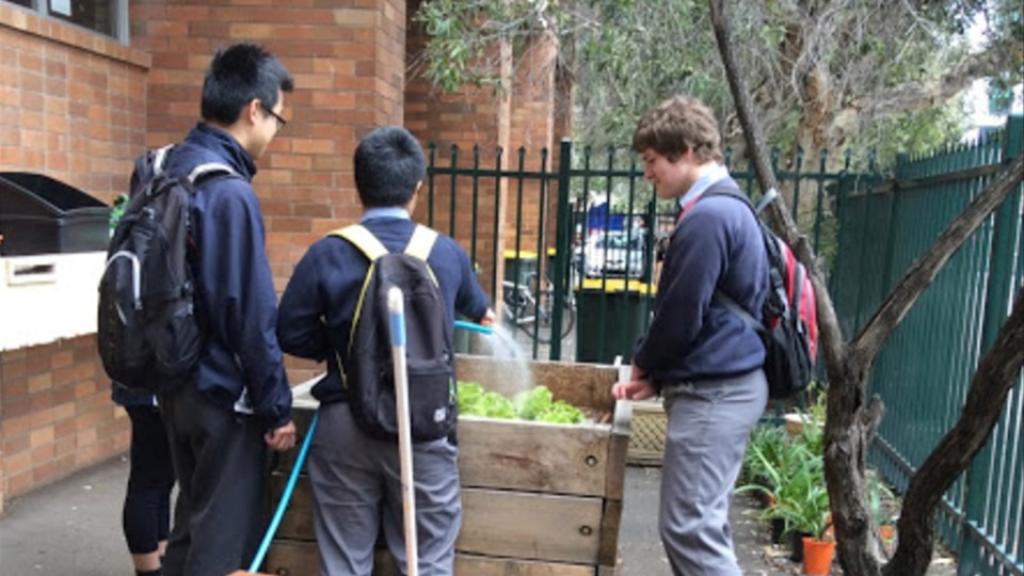Building a garden
A whole school case study: Arthur Phillip High School Sustainable Garden
Scope of project: Whole-school project that was started in 2014 and is ongoing.
School description: Arthur Phillip High School is a large school located in Parramatta, NSW. We have a very strong historic tradition in Parramatta and are proud of the way our multicultural education community operates. We are a 21st century city school with 1,450 students.
Teacher: Michelle Weatherburn
Vision and process:
The purpose of this project was to build a vegetable garden and worm farm, which would support our students’ understanding of environmental sustainability and improve our school’s overall attitude towards caring for the environment. Students were motivated to take action after attending a regional Switched on Schools summit organised by the Australian Youth Climate Coalition (AYCC) in Term 3, 2014. The garden beds had been built and developing the garden was part of our plan, but after attending the AYCC Conference the students became more motivated and became more involved in the planning and set-up of the garden.
We had an Environmental committee before the AYCC conference, but the conference encouraged more students to become involved. Most of the students ranged in age from Years 7 to 10, and this was an extra-curricula activity. Personally I have used the gardens to assist in teaching content in Year 7 and 11 Geography.
The time frame to set up the garden was six months. The $5,000-budget was covered by a grant from the Parramatta City Council.
The process was as follows:
- Year 11 students built the three garden beds as part of a project for their Construction class.
- The Environmental Committee chose the types of plants we were going to plant. Ms Choi and Mr Main (Deputy Principal) bought the plants, the soil, gardening equipment, worm farms, compost caddies and garden seats for our garden.
- The garden beds were set up and planted by the students.
- A garden roster was created to look after the gardens and make sure that they were maintained and kept tidy and the worms were fed.
Outcomes:
Through this project we have learnt that:
- Different plants require planting at different times to ensure that they survive and thrive.
- We can gauge when to water plants by sticking our fingers through the dirt to check the moisture.
- Some food scraps are more suitable for the worms than others.
- We can ensure that the worms survive.
- We can interpret and follow instruction manuals, and troubleshoot any problems we face during construction.
- Fertilisers affect the growth rate of seedlings.
This project helped us to address the following outcomes:
- Raising awareness within the school about our APHS Environmental Committee through our garden, which is visible to all students and staff.
- Increased the sense of achievement and pride within students through seeing the plants they have sown grow and thrive.
- Raised awareness within the school about how important it is to look after our local environment that starts from the immediate environment – our school.
- Improving our understanding of the essential requirements, both abiotic and biotic, for plants to thrive and how to reduce organic waste in our environment through warm farms and compost bins.
- Improving students’ wellbeing by providing them with a nice quiet green space to sit and relax during recess and lunch breaks.
Reflections:
- In the most part this project was well planned and organised. My recommendations would be to ensure that you:
- Choose an appropriate area for your garden, thinking about maintenance during the summer break. It was a major challenge for us that the plants were attacked by insects and did not receive enough water during the break, so some of our plants did not survive.
- Set up a roster for students to look after the garden
- Choose plants that are hardy and need minimal maintenance
- Have plants that can be used to teach students about food security. We grew strawberries that were made into a cheesecake and lettuces and tomatoes that we have used in salads for barbecues.
Resources used:
The labour to build the beds was provided by our enthusiastic environmental committee members, teachers and other teaching staff.
The following section outlines the things that we purchased for our garden.
Setting up TWO worm farms:
- 2 x Tumbleweed 3 Tier Worm Cafe Worm farm
- 2 x Dr Worms 1200 + Essential kit
- 2 x Tumbleweed Rectangular Worm blanket
- 3 x Willow 8L compost caddy
THREE raised garden beds made of pine wood
Equipment required to setup and maintain our garden:
- 3 x Composting tumblers
- 3 x IKEA applaro bench
- 3 x garden trowels
- 3 x 3 prong cultivators
- 2 x Oates catch all dustpan and brush set (it broke after the first or second use)
- 4 x Oates supreme garden broom
- 2 x jumbo plastic dustpan and brush sets
- 4 x mini greenhouse with seed tray
- 10 x gardening gloves
- 1 x hose end trigger gun
- 1 x vandal proof 4 way tap key
- 1 x 15 m true blue garden hose
- 10 x potting mix
Seeds and seedlings:
- Lettuce seedlings
- Onion seedlings
- Chard seedlings
- Strawberry seedlings
- Mint seedlings
- Purple carrots
- Beetroot
- Coriander
- Parsley
- Dwarf bean
- Snowpea
- Various cherry tomatoes
Link to cross curriculum priorities and/or state frameworks:
This project links to:
- Cross-curriculum priorities - Sustainability - the capacity of the environment to continue to support our lives and the lives of other living creatures in the future.
- General Capabilities - Personal and Social Capabilities, Civics and citizenship.
